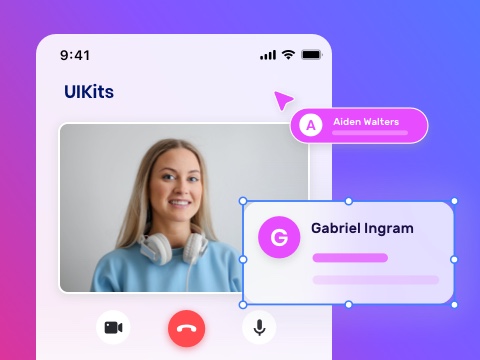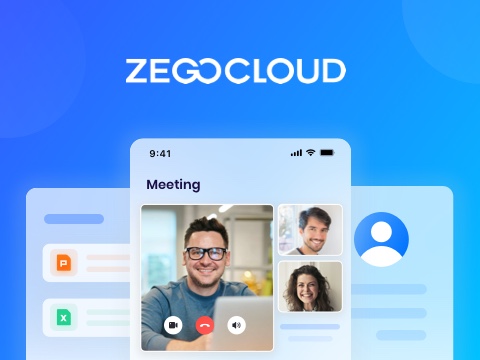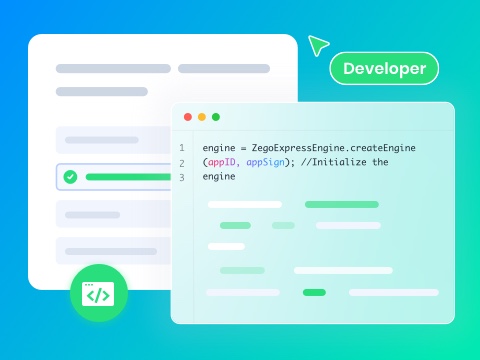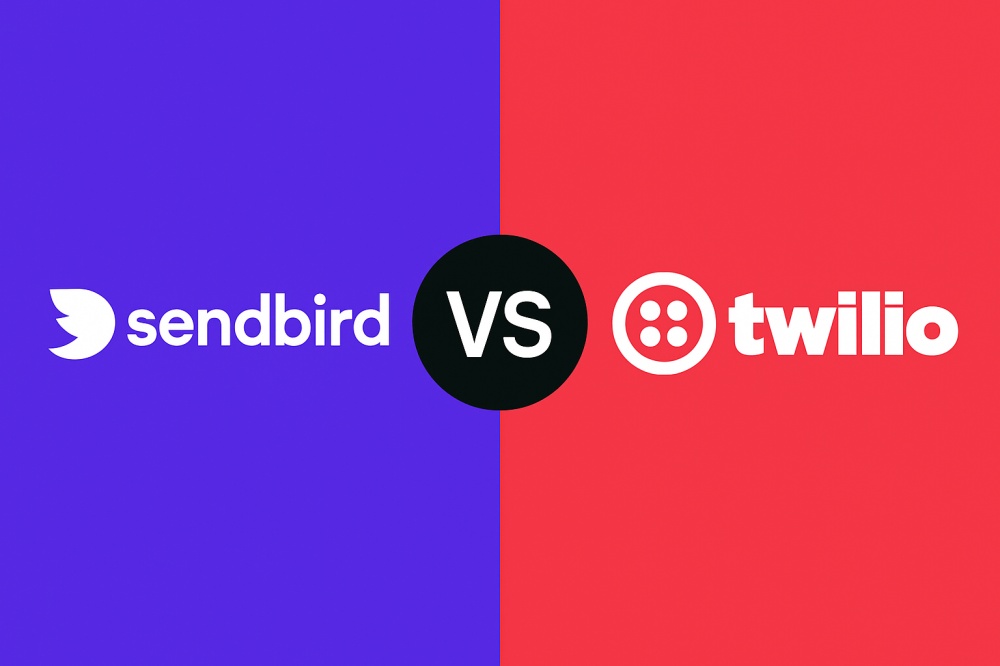When looking for the right communication platform, you might have come across two renowned names: Sendbird vs Twilio. Both platforms have new features that allow people to interact instantly, so it can be difficult to choose. So, this article will compare them so you can choose which is the best and why.
What is Sendbird?
Sendbird is a cloud service that enables developers to implement powerful features. It also provides in-app text, voice, video, and live streaming for web and mobile sites. Hence, with its numerous APIs and SDKs, it’s excellent for developing rich communication applications.
Besides, the platform allows you to have private chats, group chats, and super group chats with basic tools such as typing indicators. It also allows you to connect users via in-app alerts, push notifications, text messages, and email.
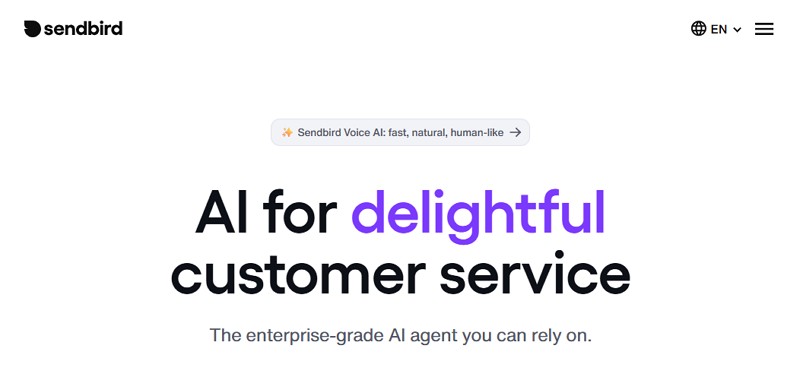
Pros and Cons of Sendbird
When a developer compares Sendbird vs Twilio chat, the first thing that comes to mind is the platform’s pros and cons. Thus, this section will highlight the positive and negative aspects of Sendbird to determine its hype.
Pros
- Chatbots, AI translation, agent builder, and moderation enhance messaging safety.
- Handles 20,000 users, unlimited messages for paid plans, efficient.
- 99.9% uptime with the global edge network ensures reliable communication.
- Fast implementation with docs and customizable UI kits provided.
- Admin panel offers user management, content moderation, and workflow tools.
Cons
- MAU-based pricing and overages can become costly.
- Features may suspend if usage or payments exceed limits.
- Pro/Enterprise plans are needed for retention and large groups.
- Lacks advanced workflows; some frameworks are unsupported, increasing dev effort.
- Out-of-order or dropped messages are possible; no exact-once delivery.
What is Twilio?
Twilio is a cloud communications platform that enables developers to embed messaging, voice, video, and email capabilities. Thus, with this, they can make interactive and compelling web and mobile applications. It provides APIs and SDKs for sending SMS, MMS, and WhatsApp messages to make video, audio, or chat applications.
In addition, it is very flexible and can grow with your needs, and help startups and big companies. This platform also features messaging on all channels, custom voice and video, AI chatbots, data analysis, and robust security and compliance tools.

Pros and Cons of Twilio
As you compare Sendbird vs Twilio, have you questioned what makes this platform better than others and where it lacks? So, review the given benefits and disadvantages of Twilio and see if it’s the right option for you:
Pros
- Supports SMS, voice, WhatsApp, email, MMS, Messenger via a single API.
- Grows smoothly from startups to global enterprise messaging needs.
- No contracts; pay only for actual usage volume.
- Reliable delivery in 180+ countries worldwide.
- APIs enable custom workflows, integrations, and enterprise communication logic.
Cons
- Per-message, call, and video costs rise quickly for high usage.
- Dashboards and APIs can overwhelm small, non-technical teams.
- Regional rates, add-ons, and confusing invoices complicate cost management.
- Rare message delays, outages, and carrier-specific failures were reported.
- Some features need third-party integration or extra coding effort.
Sendbird vs Twilio: Which One is Right for You?
If you want to compare Sendbird vs Twilio chat in detail and want to know which one is best, this section is for you. Here, we have compared both these platforms ‘ pricing and development details for better clarity:
| Metric | Sendbird | Twilio |
|---|---|---|
| Concurrent Connections | Up to 20K per chat super group (overages apply) | Up to 1,000 users per conversation |
| Platform Connections | Unlimited (subject to plan and overage fees) | Unlimited |
| Channels / Rooms | Unlimited | Unlimited |
| Message Throughput (Per Second) | ~5 messages/second default API rate; scalable on higher plans | Not publicly specified; depends on service type |
| Guaranteed Message Delivery | No (retries, but not exactly-once delivery) | No (at least once or best effort, occasional duplicates possible) |
| Guaranteed Message Order | Not guaranteed; sent in order, delivery may vary | Same — sent in order, delivery not guaranteed |
| Uptime SLA | 99.9% SLA | 99.95% for most APIs; published in SLA terms |
| Global Edge Network | Yes – 11 worldwide regions | Yes – “Twilio Edge Locations” |
| Multi-Region Data Replication | Limited (primarily within AWS zones) | Yes — multi-region redundancy across data centers |
| No Single Point Of Failure | Distributed clusters, but partial redundancy | Fully redundant hybrid cloud architecture |
| Connection State Recovery | Yes (automatic reconnection in SDKs) | Yes (SDKs support reconnection) |
| Supported Protocols | SDKs for mobile/web, REST API | SMS, MMS, WhatsApp, Facebook Messenger, SIP, WebRTC, REST API |
| Chat Room Types | Multi-type: group, DM, supergroup | 1:1 and Group |
| Presence/Reachability | Yes (real-time presence tracking in rooms) | Yes (via Conversations SDK) |
| Manual Moderation (Dashboard) | Yes (full dashboard for message/user management) | Limited; via APIs or Twilio Flex extensions |
| UIKit | Yes (Sendbird UIKit: prebuilt chat components) | Yes (prebuilt UI for several communication types) |
| Synchronous Moderation | Yes (pre-message, advanced AI-based) | Third-party only |
| Developer Tools & APIs | Full SDKs, API, automation, dashboard | Full SDKs, API, CLI, dashboard |
| Analytics (Basic & Advanced) | Message counts, DAUs, MAUs, user/channel insights | Flex insights, custom metrics, voice/message analytics |
| Security | Strong enterprise security; ISO 27001, GDPR, SOC2 compliant | Enterprise-grade; HIPAA, GDPR, ISO 27001 certified |
| Programmatic Management | Yes | Yes |
| User Satisfaction (G2) | Generally higher, especially for data security and analytics | Slightly lower for support and analytics |
ZEGOCLOUD: A Better Alternative to Sendbird and Twilio
If you are comparing Sendbird vs Twilio to find the right communication solution for your business, you’ll notice that both focus on specific areas: Sendbird specializes in chat, while Twilio is widely used for programmable messaging and voice APIs. However, if you’re looking for an all-in-one platform that brings together real-time voice, video, chat, and AI-powered capabilities, ZEGOCLOUD offers a more comprehensive alternative.

The comparison below highlights how ZEGOCLOUD stands out in performance, scalability, and intelligent communication features.
| Feature | ZEGOCLOUD | Sendbird | Twilio |
|---|---|---|---|
| Main Focus | Real-time communication with AI-driven capabilities | In-app chat and messaging | Programmable voice, SMS, and video APIs |
| Core Products | Video, voice, chat, AI voice agents, digital humans | Chat, group channels, moderation | SMS, voice, email, and video APIs |
| SDK & UIKits | 18+ SDKs and 20+ prebuilt UIKits for faster integration | SDKs for chat (iOS, Android, JS) | SDKs for voice, SMS, and video |
| AI Capabilities | Super-resolution, AI noise reduction, digital humans, AI voice agents | Basic content moderation APIs | Limited AI-based communication tools |
| Latency | 300 ms global average and 79 ms best record | Moderate latency depending on region | 400–600 ms depending on network |
| Scalability | Supports up to 10,000 participants and 10 million+ live viewers | Suitable for small to medium chat apps | Enterprise-grade but complex setup |
| Pricing | Flexible options with 10,000 free minutes per month | User-based chat pricing | Pay per message or minute |
| Best For | Real-time social, education, healthcare, and enterprise apps | Messaging-centric applications | Large-scale communication services |
Compared to Sendbird and Twilio, ZEGOCLOUD provides broader functionality, easier integration, and more advanced AI support. Its low-latency global network ensures seamless real-time communication, while flexible SDKs and pricing make it suitable for both startups and large enterprises.
For organizations seeking a unified and intelligent alternative to Sendbird and Twilio, ZEGOCLOUD delivers a platform built for performance, scalability, and innovation.
Conclusion
Summing up, Sendbird vs Twilio are no doubt great development solutions, but they lack in terms of message delivery and latency. Therefore, this guide has compared these solutions in detail so that you can make a decision for yourself. However, we suggest using ZEGOCLOUD, as the platform ensures an average global latency of 300ms, with a best record of 79ms.
FAQ
Q1: What is the difference between Sendbird and Twilio?
Sendbird focuses mainly on in-app chat and messaging with ready-to-use SDKs for web and mobile apps. Twilio, on the other hand, offers a broader communication infrastructure, including programmable voice, video, and SMS APIs that can be customized for various enterprise use cases.
Q2: Which platform is better for chat integration?
If your product mainly relies on text-based communication, Sendbird provides more specialized chat features like moderation, group channels, and delivery receipts. However, if you need an integrated solution for chat, voice, and video, ZEGOCLOUD offers a more comprehensive toolkit for real-time communication.
Q3: Is Twilio more expensive than Sendbird?
Twilio typically uses a pay-per-message or per-minute model, which can become costly as usage scales. Sendbird’s pricing is user-based, making it easier to predict costs but less flexible for dynamic workloads. ZEGOCLOUD provides flexible pricing plans that include 10,000 free minutes, allowing teams to scale without heavy upfront costs.
Q4: Are there better alternatives to Sendbird and Twilio?
Yes. ZEGOCLOUD is a strong alternative that combines real-time messaging, voice, video, and AI-powered features in one platform. It helps developers build interactive apps faster with prebuilt UIKits, global low-latency coverage, and powerful analytics for quality monitoring.
Let’s Build APP Together
Start building with real-time video, voice & chat SDK for apps today!


